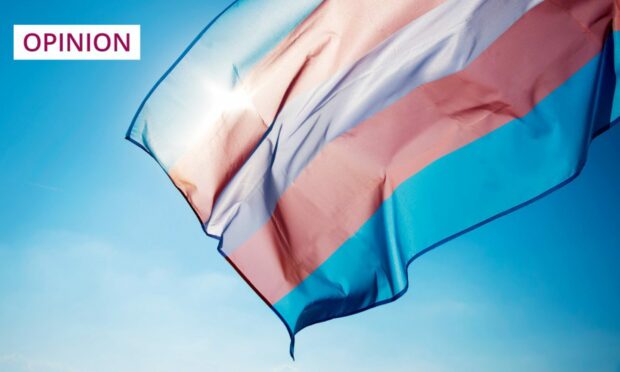Yet another almighty row between the Scottish and UK Governments won’t achieve much when it comes to gender recognition reform, writes Fiona Rintoul.
“What is gender identity?” former Guardian columnist Suzanne Moore asked on Twitter last week, after Alister Jack announced that the UK Government will use a section 35 order to prevent Holyrood’s freshly minted Gender Recognition Reform Bill gaining royal assent.
It’s a good question – and she posed other equally good ones. What’s the difference between gender identity and regressive gender stereotypes? Does everyone have a gender identity, and when do you get one?
Kind of hard to say, intit? The Merriam-Webster dictionary defines gender identity as “a person’s internal sense of being male, female, some combination of male and female, or neither male nor female” – which is about as easy to conceptualise as divine consciousness or an infinite universe.

Posing pesky questions of this ilk was doubtless the catalyst for veteran journalist Moore and The Guardian – now an uncomfortable billet for so-called gender critical (what does that mean?) feminists – to part ways. But they are valid questions that we dismiss at our peril.
I remember a time – I have to say, with some fondness – when my primary interaction with gender was learning whether to use the definite article der, die or das in front of German nouns. Now, gender identity is a corpse-strewn battlefield in something called the culture wars.
I’m always suspicious of jargon, which usually exists to obscure rather than to clarify. If you take a deep dive into discussions about gender identity, you shall surface spattered with acronyms and neologisms – but the none the wiser, I’ll wager, as to the answers to Moore’s questions.
That does not mean that gender identity does not exist. We cannot know if an internal sense exists or not. But it is jolly hard to legislate for.
How will gender recognition work in practice?
Enter the Scottish Government, guns blazing, more progressive than thou. My personal jury is out on the Gender Recognition Reform Bill. It will depend how it works in practice – if it is ever put into practice.
If allowing people to self-identify as the opposite gender to the sex on their birth certificate makes trans people’s lives easier without impinging on anyone else, that’s fine by me.
If allowing people to self-identify as the opposite gender to the sex on their birth certificate makes trans people’s lives easier without impinging on anyone else, that’s fine by me
However, many women will not feel comfortable sharing changing rooms or other single-sex spaces with people who have self-identified as women, but are, in all other respects, men. Putting my hand up here. We must address this issue, and the kneejerk cries of bigot that accompany any attempt to do so are dispiriting.
For me, that is the biggest stumbling block with the new legislation. It is not the words on the pages of the bill that vex me. It is that way that legitimate concerns about the impact of self-ID on women’s security have been rubbished – quite often by shouty men.
This row is not about self-ID, nor Scotland’s sovereignty
Now, the stage is set for an almighty row between the Scottish and UK Governments over the new law. Yes, compadres, another one.
It’s all too easy to pick a side based on how you feel about self-ID, or about the sovereignty of the Scottish parliament. But, at root, this is about neither of those issues.
Predictably, First Minister Nicola Sturgeon has styled the section 35 order as an assault on Scottish democracy. And the idea of Westminster overruling Holyrood is uncomfortable. But, if the new bill conflicts with the 2010 Equality Act, as Scottish Secretary Alister Jack claims, then a section 35 order is legitimate.
In a union, members cannot pass legislation that undermines union-wide laws. It would be the same if we were in the European Union.
The problem for the UK Government is that it is very difficult to see how the Scottish bill conflicts with the 2010 Equality Act. The Gender Recognition Reform Bill does not change the rights that a gender recognition certificate confers; it only changes the process for obtaining one.
Alister Jack’s slightly rambling published reasons for his intervention suggest that having divergent systems within the UK is a huge problem. But it’s hardly the first time that Scots and English law have diverged.
It’s not a constitutional showdown
In 1967, homosexuality was decriminalised in England and Wales, but not in Scotland or Northern Ireland. The marriage process for under-16s remains different in Scotland from south of the border.
This has nothing to do with devolution. It’s about us having our own legal system because we are our own country.
If the 2010 Equality Act is destabilised by the new Scottish bill, then it is perhaps not robust enough.
In the end, provided applicants are genuine, it doesn’t really matter how they obtain a gender recognition certificate. What matters is the rights that the certificate confers on them, and how those rights interact with other people’s rights.
That is the lesson from this debacle. It’s not a constitutional showdown. It’s about semantics. We must be able to answer Suzanne Moore’s questions. What is gender identity? Then we can proceed.
Fiona Rintoul is an author and translator



Conversation